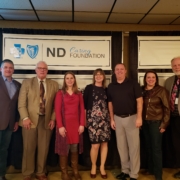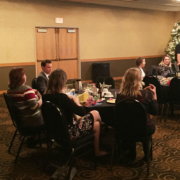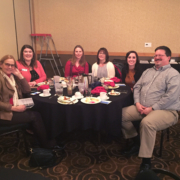Tobacco tax increase proposed in ND
by John Salling KFYR-TV
North Dakota has the fourth lowest state tobacco tax in the country. Forty-four cents a pack, only Missouri, Virginia and Georgia have a lower tax.
Tobacco Free NORTH DAKOTA says that tobacco related health problems are the leading cause of death in North Dakota. They proposed to the Interim Health Commission to raise the tobacco tax to a dollar ninety four per pack of cigarettes.
“Costs of many things have gone up in the last twenty five years, but our tax rate has held steady and so the value of that tax dollar has diminished over time as health care costs rise, as insurance rates rise,” said Heather Austin, Tobacco Free North Dakota executive director.
Tobacco Free North Dakota also wants to add a tax for electronic cigarettes, which they say currently aren’t taxed in North Dakota.https://www.kfyrtv.com/content/news/Tobacco-tax-increase-proposed-in-ND-489366741.html
The Great American Smoke Out
By Malique Rankin KX News
Today is the Great American Smoke out– where thousands of Americans say no to cigarettes. The event is sponsored by the American Cancer Society, and they’ve helped tobacco users quit smoking for more than 40 years. For people on the fence about quitting, the goal is to give them a day to make it happen. North Dakota’s smoking rate is at 19.8 percent, nearly 6 percent higher than the national average, according to the Campaign for Tobacco Free Kid. We spoke with one man who has been tobacco free for over 20 years on how he made the life-changing decision.
Jerry Grosz; Tobacco Free: “Well I look at the fact that my family, I didn’t want them to be subjected to that environment. And just, personal health.”
Tobacco use is the leading cause of preventable death and disease in North Dakota.
https://www.kxnet.com/news/bismarck-news/the-great-american-smoke-out/1600512878
University of Mary Community Fair
We had a great time getting to talk to students about TFND at the University of Mary Community Fair.

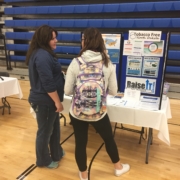
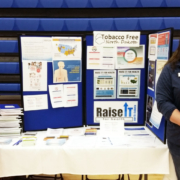
Jamestown Community Block Party



TFND had a great time participating in the Community Block Party in Jamestown last week!
UND Studio One interviews Grand Forks Public Health Tobacco Prevention Coordinator
From University of North Dakota’s Studio One:
Tobacco was the first cash crop grown in North America starting in 1612. Since then, mass amounts of money have gone towards both selling tobacco and preventing its use.
Studio One is a live television show produced by the University of North Dakota’s Television Center. The Television Center offers an extensive internship program through Studio One. An internship with Studio One provides valuable on-the-job experience, a chance to make professional contacts and the opportunity to work on an award winning project. Visit studio1.und.edu for more information.
Tobacco Prevention Coordinator at Grand Forks Public Health, Kailee Dvorak, is here to tell us why prevention and control of tobacco is so important.
To watch the video, click here: https://vimeo.com/162000999
Grand Forks has been putting time and money into the prevention of tobacco use, and Tobacco Prevention Coordinator Kailee Dvorak says that laws have been passed to help this effort. “Breathe ND, or the Center for Tobacco Prevention and Control Policy, was formed after an initiated measure back in 2008. It was called Measure 3 back then. The voters of North Dakota passed that measure, and by law it formed the Center for Tobacco Prevention and Control Policy, which states that tobacco settlement dollars, specifically the strategic contribution funds, so a portion of the tobacco settlement dollars that come into the state of North Dakota, are spent on tobacco prevention and control,” said Dvorak.
The Campaign for Tobacco-Free Kids says North Dakota is the only state that is spending enough money on tobacco prevention. Dvorak says that they are also doing things locally to continue to make progress. “Here in Grand Forks we receive funds from the center (Breathe ND) to work locally on tobacco prevention and control policy in accordance to CDC best practices,” says Dvorak.
There are many schools involved with trying to prevent their students from using tobacco. UND is one school that takes tobacco use very seriously. “The funding that we utilize locally we’ve also been able to partner with UND, so that tobacco prevention policy efforts can happen on campus,” said Dvorak.
There have been studies done to show how much progress has been made in tobacco prevention in North Dakota. “From 2009-2015, smoking among North Dakota’s high school students fell by 48%,” said Dvorak. There was also a study that showed the mean level of indoor air pollution in Grand Forks went down by 92% after the law was passed.
Dvorak and her co-workers work every day to help the community fight the tobacco industry. They take their goals very seriously in an effort to keep young people away from tobacco. “One of our main goals is preventing youth initiation and also decreasing tobacco use rates across the board and changing that social norm,” said Dvorak.
One thing that some people might not know is these efforts aren’t funded by the community. “We aren’t funded by taxpayers,” said Dvorak. The efforts are funded by tobacco settlement dollars.
Inquisitr: 7 Reasons E-Cigarettes Are Bad
E-cigarettes, also known as electronic cigarettes, have become a popular alternative to smoking the real deal, but the pros and cons of turning to this futuristic alternative are still under debate. Are e-cigarettes really any better than smoking a cigarette? Here are seven reasons e-cigarettes pose dangers to our health.
The effects of e-cigarettes are nowhere near as well-documented as cigarettes.
The e-cigarette industry is already worth billions of dollars, but there is nowhere near as much information on e-cigarettes as tobacco products. This should raise alarms, as the tobacco industry lived under a veil of scientific obscurity for decades until the detrimental health effects of cigarettes became well-known. Many people think e-cigarettes are a safer alternative, but that belief remains scientifically unproven, and evidence continues to come out saying e-cigarettes have toxic effects.
E-cigarettes contain plenty of cancerous chemicals.
“In 2009, the FDA conducted lab tests and found detectable levels of toxic cancer-causing chemicals, including an ingredient used in antifreeze, in two leading brands of e-cigarettes and 18 various cartridges. A 2014 study found that e-cigarettes with a higher voltage level have higher amounts of formaldehyde, a carcinogen. It is urgent for FDA to begin its regulatory oversight of e-cigarettes, which would require ingredient disclosure to FDA, warning labels and youth access restrictions.”
Also, a 2013 study from the German Cancer Institute detected 8 different toxic chemicals in various e-cigarette liquids. And because the e-cigarette industry remains largely unregulated, the chemicals found in e-cigarettes aren’t uniform across the market. Some products may be less toxic than others, but without enough research or regulation it’s hard to know.
E-cigarettes are just as addictive as smoking tobacco.
E-cigarettes and tobacco products have the same highly addictive drug: nicotine. E-cigarettes derive nicotine from traditional cigarettes, delivering the same drug in a smokeless (vapor) form. In July, Daily Mail reported on a study by the American University of Beirut and the Center for the Study of Tobacco Products which demonstrated e-cigarettes contained highly addictive forms of nicotine. E-cigarettes might not have the same carcinogenic materials as cigarettes (like tar), but its nicotine still fosters addiction.
E-cigarettes have negative effects on lungs.
A supposed benefit of e-cigarettes is inhaling vapor instead of smoke. However, e-cigarette vapor is turning out to have a destructive effect on lungs. A recent July analysis by the University of Athens claimed that “using an e-cigarette caused an instant increase in airway resistance that lasted for 10 minutes.” Put simply, smoking e-cigarettes unhealthily constrains your airways.
Additionally, a study published in May by Indiana University showed that even nicotine-free e-cigarette vapor had damaging effects on the endothelial cells of the lungs. Endothelial cells protect the lungs from infections, so damaging them can’t be good for your immune system.
E-cigarettes won’t help you quit.
A lot of people vape e-cigarettes because they think it will help them kick their addiction. But recent research, including a comprehensive study by UC San Francisco, show that e-cigarettes don’t provide any extra help in quitting smoking. After surveying 849 smokers, the researchers found that users of e-cigarettes weren’t more likely to quit smoking.
“We found that there was no difference in the rate of quitting between smokers who used an e-cigarette and those who did not,” said head researcher Dr. Pamela Ling, a professor at the Center for Tobacco Control Research and Education at UC San Francisco.
E-cigarettes might create the equivalent of secondhand smoke.
Even if you don’t smoke, avoiding smokers is good for your health. But the American Lung Association point out e-cigarettes can also create the equivalent of toxic secondhand smoke, secondhand vapor.
“Also unknown is what the potential harm may be to people exposed to secondhand emissions from e-cigarettes. Two initial studies have found formaldehyde, benzene and tobacco-specific nitrosamines (all carcinogens) coming from those secondhand emissions. Other studies have shown that chemicals exhaled by users also contain formaldehyde, acetaldehyde and other potential irritants. While there is a great deal more to learn about these products, it is clear that there is much to be concerned about, especially in the absence of FDA oversight.”
E-cigarettes could be a gateway into tobacco products for youth.
The tobacco industry spends millions of dollars advertising to youth, and it turns out e-cigarettes might be helping convince young people to smoke nicotine. Here’s a summary of studies from the American Lung Association.
“The American Lung Association is concerned about e-cigarettes becoming a gateway to regular cigarettes, especially in light of the aggressive industry marketing tactics targeted at youth—including the use of candy flavors and the glamorization of e-cigarette use. Studies are showing a dramatic increase in usage of e-cigarettes, especially among youth. For the first time ever, a national study released in December 2014 found e-cigarette use among teens exceeds traditional cigarette smoking. The study also found that e-cigarette use among 8th and 10th graders was double that of traditional cigarette smoking. CDC studies have also shown e-cigarette use among high school students increased by 61 percent from 2012 to 2013.”
Another study, conducted this August by the University of Southern California, found that teenagers who try e-cigarettes are more likely to smoke tobacco. The researchers sampled 2,500 9th graders who had never had smoked a cigarette, finding those who tried vaping e-cigarettes were 23 percent more likely to smoke a tobacco cigarette over those who had never tried an e-cig. On top of that, one-fourth of the surveyed youth who tried e-cigarettes admitted to smoking tobacco cigarettes within the last 6 months.
http://www.inquisitr.com/2378144/7-reasons-e-cigarettes-are-bad/
NDSU Study: "Tobacco Goes to College" Shows Battle for Youth Market Began Early
Source Newsroom: North Dakota State University
Newswise — While the character Don Draper in the television show Mad Men looked for a way to first save his cigarette advertising accounts, and then to distance himself from them, a new book—“Tobacco Goes to College”—shows the power of advertising impacted would-be-smokers long before the Mad Men era.
Elizabeth Crisp Crawford, associate professor in the Department of Communication at North Dakota State University, Fargo, studied how tobacco advertising from 1920 to 1980 targeted college students.
“The tobacco industry had a strong presence on campus and an influence on college media,” said Crawford. “Tobacco’s influence on college media included campus newspapers, radio, and sporting events. This influence affected students on campus the most—due to a high level of advertising exposure. However, the viewing audiences for college sports also were exposed to cigarette promotion facilitated by the NCAA.”
In her research for “Tobacco Goes to College: Cigarette Advertising in Student Media, 1920-1980,” Crawford found the advertising plans and creative tactics to be extremely strategic over the six decades studied. Social pressure and social appeals hit the mark with potential college consumers.
“The advertising campaigns were well organized and sophisticated,” said Crawford. “In this way, tobacco was ahead of its time. The ads are really an important piece of advertising history for these reasons.”
The successful advertising tactics, said Crawford, are still being used today for a variety of products.
“I see the industry using many of the same tactics it used 50 years ago with cigarettes—especially the filtered brands. When we discuss the promotion of e-cigarettes, I think that we need to look at the history of tobacco advertising,” said Crawford.
Key insights into the target market make these ads successful.
“The tobacco industry has an excellent understanding of the psychology of human need,” said Crawford. “People use substances to cope with their lives. Sometimes life can be stressful and people lack the needed human support. Tobacco has always positioned itself as a way to fill a social or emotional void.”
Crawford’s book contains an in-depth analysis of vintage cigarette ads.
“Jane Wyman – famous Barnard Alumna says: ‘Chesterfields always give me a lift. They’re wonderfully mild and taste so good. They’re my favorite cigarette,’” according to an ad which ran in NDSU’s student newspaper, The Spectrum, on April 7, 1950.
Similar ads ran in student newspapers across the country including Smith College, University of Portland, Elon University, and in football programs at colleges, including the University of Tennessee at Knoxville (Crawford’s alma mater), at Chattanooga, and Illinois vs. Stanford.
“Tobacco advertisers knew college students’ needs and positioned their product in a way that could help fulfill these needs,” said Crawford.
In 1963, the Tobacco Institute pulled tobacco advertising from college publications. Crawford points out that nearly 2,000 publications then looked for ways to recover what amounted to as much as 50 percent of lost revenue from the ads.
Crawford’s interest in this particular area of research also has a personal link. “Of my four grandparents, the two that attended college smoked. I found this connection to be interesting,” she said.
“Tobacco Goes to College” was named an Outstanding Academic Title by Choice Magazine in 2014. The list comprises about 10 percent of more than 7,000 titles reviewed by Choice each year. According to Choice reviewer N.E. Furlow, “In short, the book offers a detailed inside look at the tobacco industry’s calculating strategy to entice a young population to use its products.” The book is published by McFarland & Company, Inc.
In reviewing the book in American Journalism, Stephen Siff wrote: “It is on the final point, about the quality and inventiveness of cigarette advertising, that the book is most effective and, ultimately, makes its greatest contribution.”
In Journalism History, reviewer Kari Hollerbach wrote: “By examining the broader social and legal trends that buffeted the tobacco industry, the targeted effort to recruit and retain college-age smokers, and the actual advertisements and their thematic narratives, she offers a very compelling explanation as to how and why several generations of American youth were persuaded to smoke, smoke, smoke that cigarette.”
Figures show the continued compelling force of advertising. According to a CDC report, tobacco companies spent $9.6 billion marketing cigarettes and smokeless tobacco in the United States alone in 2012. That’s equivalent to more than $1 million every hour, based on $26 million daily. A Federal Trade Commission report shows $9.2 billion spent on cigarette advertising and promotion in 2012. The report notes the expenses include magazine ads, distribution of samples and coupons, retail ads, discounts, retailer payments, rebates and direct-mail advertising.
A Gallup-Healthways Well-Being Index showed the national smoking rate at 19.7 percent in 2013, with North Dakota’s smoking rate dropping from 24.1 percent in 2008 to 18.5 percent in 2013. Kaiser Family Foundation data show the national smoking rate at 18.1 percent in 2013 and North Dakota at 21.2 percent.
Crawford’s research has been published in Journalism and Mass Communication Educator, Social Marketing Quarterly, and the Journal of Health and Mass Communication. Crawford joined NDSU in 2009. She received a doctorate degree in communication and information from the University of Tennessee, Knoxville, and a master’s degree in advertising and public relations from Marquette University, Milwaukee, Wisconsin.
About NDSU
NDSU, Fargo, North Dakota, USA, is notably listed among the top 108 U.S. public and private universities in the Carnegie Commission on Higher Education’s category of “Research Universities/Very High Research Activity.” NDSU is listed in the top 100 research universities in the U.S. for R&D in agricultural sciences, chemistry, computer science, physical sciences, psychology, and social sciences, based on research expenditures reported to the National Science Foundation. As a student-focused, land grant, research institution, NDSU serves the state’s citizens. www.ndsu.edu/research
http://newswise.com/articles/tobacco-goes-to-college-shows-battle-for-youth-market-began-early
Our Organization
More
Partners
More
Coalition
More


